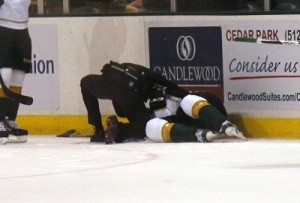For the first time in over 15 years, the American Academy of Neurology (AAN) has issued a revision to their standard guidelines for sports-related concussions. Despite endorsement by the National Football League Players Association, they are not endorsed by North American pro hockey organizations.
The previous guidelines included a grading system as well as a set-in-stone 10-day waiting period before a player could return to play. Both the grading system and the set waiting period have been eliminated.

While players who are suspected of having experienced a concussion are still to be removed from play immediately, return to play is now considered flexible—it can be guided by symptoms and risk of further injury.
The guideline revision was announced at the annual meeting of the AAN taking place this week in San Diego, as well as having been published online in the journal Neurology.
They are derived from an evidence review conducted by Christopher Giza, MD, of the University of California Los Angeles, and colleagues. That review found no support for a mandatory 10 day waiting period:
“We’ve moved away from the concussion grading system we first established in 1997 and are now recommending [that] concussion and return to play be assessed in each athlete individually. There is no set time line for safe return to play.”
Other highlights of the review include:
- Athletes should make a slow, gradual return to play, and only after all acute symptoms have disappeared;
- All concussion evaluations ought to be performed by licensed professionals with specific training in concussions;.
- Among males, the risk for concussions is highest in football and rugby, followed by hockey and soccer. Among females, concussion risk is highest in soccer and basketball.
It should be noted that while these guidelines were developed by a panel assembled by the AAN and are endorsed by other professional societies as well as the National Football League Players Association (NFLPA), they have not yet been endorsed by any professional hockey league or hockey players’ association, including the NHL and the NHLPA, which use their own evolving protocol.
It should also be noted that the new guidelines do not address the disease widely associated with repeated head injury and found in the autopsies of former NHLers Bob Probert, Reggie Fleming and Rick Martin, chronic traumatic encephalopathy (CTE). According to review co-author Jeffrey Kutcher, MD, of the University of Michigan in Ann Arbor, this is because these are evidence-based guidelines, and CTE is “an anecdotal diagnosis” supported only by case reports at this point.
The AAN’s Sports Concussion Toolkit contains concussion-related resources for athletes, parents, and coaches as well as a link to its most recent guidelines.
[Must Read: Concussions: This is Your Brain on Hockey]
SOURCE
Giza C, et al. Summary of evidence-based guideline update: Evaluation and management of concussion in sports: Report of the Guideline Development Subcommittee of the American Academy of Neurology. Neurology 2013.